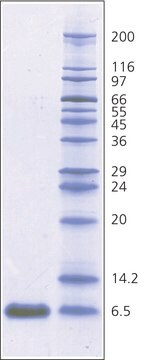101500
AEBSF, Hydrochloride
AEBSF, CAS 30827-99-7, is a specific irreversible inhibitor of chymotrypsin, kallikrein, plasmin, thrombin, trypsin, and related thrombolytic enzymes. A nontoxic alternative to PMSF and DFP.
Synonym(s):
AEBSF, Hydrochloride
About This Item
Recommended Products
Quality Level
Assay
>97% (HPLC)
form
solid
manufacturer/tradename
Calbiochem®
storage condition
OK to freeze
desiccated
color
white to off-white
solubility
water: 25 mg/mL
shipped in
ambient
storage temp.
−20°C
InChI
1S/C8H10FNO2S.ClH/c9-13(11,12)8-3-1-7(2-4-8)5-6-10;/h1-4H,5-6,10H2;1H
InChI key
WRDABNWSWOHGMS-UHFFFAOYSA-N
General description
Biochem/physiol Actions
chymotrypsin
Packaging
Warning
Reconstitution
Other Notes
Ohkubo, I., et al. 1994. J. Biochem. 116, 1182.
Mintz, G.R. 1993. BioPharm. 6, 34.
Lawson, W.B., et al. 1982. Folia Haematol.109, 52.
Markwardt, F., et al. 1974. Biochem. Pharmacol.23, 2247.
Markwardt, F., et al. 1973. Thromb. Res.2, 343.
Baker, B.R., and Cory, M. 1971. J. Med. Chem.14, 119.
Legal Information
Signal Word
Danger
Hazard Statements
Precautionary Statements
Hazard Classifications
Eye Dam. 1 - Skin Corr. 1A
Storage Class Code
8A - Combustible corrosive hazardous materials
WGK
WGK 3
Flash Point(F)
Not applicable
Flash Point(C)
Not applicable
Regulatory Listings
Regulatory Listings are mainly provided for chemical products. Only limited information can be provided here for non-chemical products. No entry means none of the components are listed. It is the user’s obligation to ensure the safe and legal use of the product.
JAN Code
101500-5GM:
101500-6GM:
101500-500MG:
101500-VMG:
101500-50MG:
101500-1GM:
101500-100MG:
Certificates of Analysis (COA)
Search for Certificates of Analysis (COA) by entering the products Lot/Batch Number. Lot and Batch Numbers can be found on a product’s label following the words ‘Lot’ or ‘Batch’.
Already Own This Product?
Find documentation for the products that you have recently purchased in the Document Library.
Customers Also Viewed
Articles
YeastBuster™ Protein Extraction Reagent for Fast, Efficient Extraction of Proteins from Yeast
Our team of scientists has experience in all areas of research including Life Science, Material Science, Chemical Synthesis, Chromatography, Analytical and many others.
Contact Technical Service














